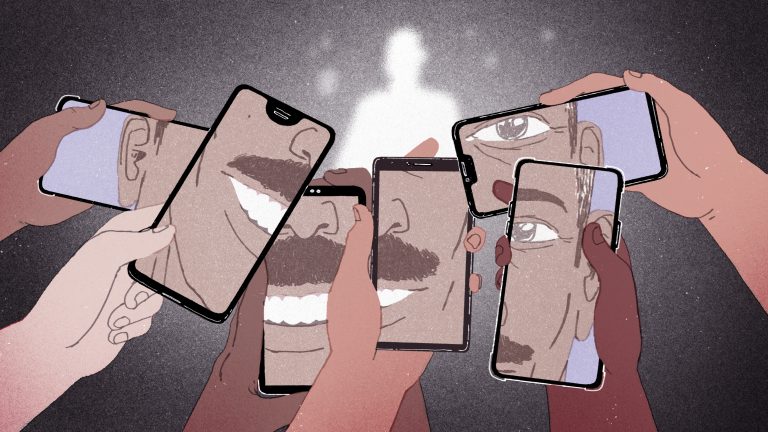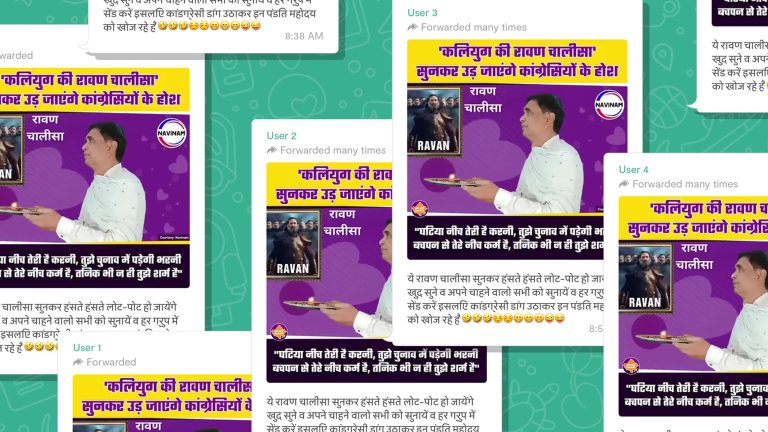Last month, movie star-turned-politician Vijay Vasanth was campaigning in an open jeep under an unforgiving sun in the sleepy fishing town of Kanniyakumari, the southernmost tip of the Indian mainland. He periodically waved to the fisherfolk lined up on either side of the street. Sometimes, as the vehicle slowed down, kids clambered up the bonnet and tugged at his sleeves for sweets that he kept in a container up front.
It’s classic electoral campaigning. And it’s hard work.
But in a hyper-wired world, it’s no longer considered enough.
Vasanth’s campaign manager, a young man in his 20s, pulled out his phone to show me a video in which a gentleman in a crisp white kurta and neatly folded scarf leans back against a tall chair. He is H. Vasanth Kumar — the candidate’s father, a local businessman, and the previous parliamentary representative of this constituency.
Except Kumar is no longer alive. He died from Covid-19 four years ago.
Kumar, who began his career as a salesman before starting a successful consumer goods company, typically had billboards across Kanniyakumari plastered with images of him advertising his business. His son’s campaign team wants to recreate the familiarity of those images. In the video, Kumar, speaking in Tamil, explains how “though I died, my soul is still with all of you.” He goes on to extol the virtues of his son: “I can assure you that my son, Vijay, will work for the betterment of Kanniyakumari and for the progress of your children.”
As elections in India get in full swing, the country’s leading politicians and their brand gurus have gone all in on artificial intelligence to resurrect the past and manage the future. Digital rights activists have questioned the ethics of using a deceased politician’s voice or form in elections. There’s the question of rights — who owns their legacy? — but more importantly, there’s a humanizing aspect to “soft fakes,” as they are called. No one wants to speak ill of the dead, especially in India, where we have been culturally shaped to only eulogize those no longer with us.
In January this year, M. Karunanidhi, the patriarch of politics in the southern state of Tamil Nadu, first appeared in an AI video at a conference for his party’s youth wing. In the clip, he wore the look for which he is best remembered: a luminous yellow scarf and oversized dark glasses. Even his head was tilted, just slightly to one side, to replicate a familiar stance from real life. Two days later, he made another appearance at the book launch of a colleague’s memoirs.
Karunanidhi died in 2018.
“The idea is to enthuse party cadres,” Salem Dharanidharan, a spokesperson for the Dravida Munnetra Kazhagam (DMK) — the party that Karunanidhi led till his death — told me. “It excites older voters among whom Kalaignar [“Man of Letters,” as Karunanidhi was popularly called] already has a following. It spreads his ideals among younger voters who have not seen enough of him. And it also has an entertainment factor — to recreate a popular leader who is dead.”
Across the world, countries are grappling with similar dilemmas.
Americans, for instance, banned robocalls, or AI-generated voice calls. Fake robocalls, impersonating President Joe Biden’s voice, were used to try and persuade citizens not to vote in the New Hampshire primaries. The cloning was most likely done using ElevenLabs, one of Silicon Valley’s most successful startup stories. The company’s technology was also used to generate AI videos of Imran Khan, the jailed former Pakistani prime minister. And it’s open to all — no prior permissions are needed from the person being imitated. ElevenLabs separately categorizes cloning used for “non-commercial purposes,” like politics and public debate.
In the hurly-burly of the Indian election season, though, all this is entirely esoteric and academic.
No one wants to speak ill of the dead, especially in India, where we have been culturally shaped to only eulogize those no longer with us.
According to Dharanidharan, AI for politicians is a mere mechanism, much like the newspaper or printing press were back in the day. “In the 1920s, our party used newspapers as a medium to propagate ideology; in the late ’40s up to the ’80s, we used film and cinema; in the ’90s, we used cable TV — and now it’s AI.”
India’s prime minister, Narendra Modi, has been an early user of an AI app called Bhashini, which translates his voice from Hindi to other languages in real time. Shashi Tharoor, a minister from the opposing Indian National Congress, conducted an interview with his AI avatars. And as AI goes mainstream, the first big quarrel between the ruling Bharatiya Janata Party and the Congress party has led to a police summons: Home Minister Amit Shah alleged that Revanth Reddy, the Congress’ recently elected chief minister in Telangana, used deepfake tech to alter a video that twisted Shah’s views on affirmative action quotas.
Not surprisingly, new businesses that boast about providing the ultimate guide to creating deepfakes are suddenly much in demand.
But as the lines between real and fake blur, manipulation is fast becoming a challenge — and it’s far more dire than when misinformation used to be exchanged via text messages or WhatsApp forwards. Two of India’s biggest movie stars had to deny that they had issued messages urging people to vote against the ruling party.
Voters are now receiving calls from supposed local representatives who engage in a full-blown conversation about the most pressing issues in their area — except they never actually made the call.
The full impact of AI on voting choices may not be understood in this election cycle. But if effective public communication was once all about human connection and authenticity, generative AI seems to have turned that premise on its head.



